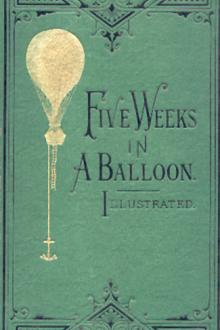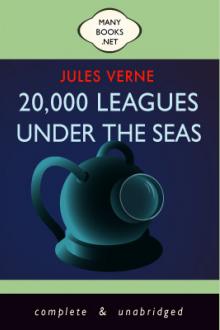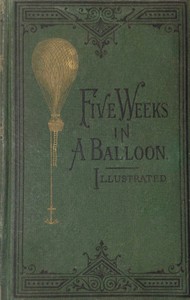The Mysterious Island, Jules Verne [inspiring books for teens TXT] 📗

- Author: Jules Verne
Book online «The Mysterious Island, Jules Verne [inspiring books for teens TXT] 📗». Author Jules Verne
“Hurrah!” cried Pencroff, “the roast is here; now we can go back to the house.”
The journey was resumed. Red Creek still rolled its limped waters under the arching boughs of casuarence, bankseas and gigantic gum trees. Superb liliaceæ rose, to a height of twenty feet, and other arborescent trees of species unknown to the young naturalist, bent over the brook, which murmered gently beneath its leafy cradle. It widened sensibly, nevertheless, and the mouth was evidently near. As the party emerged from a massive thicket of fine trees, the lake suddenly appeared before them.
They were now on its left bank, and a picturesque region opened to their view. The smooth sheet of water, about seven miles in circumference and 250 acres in extent, lay sleeping among the trees. Towards the east, across the intermittent screen of verdure, appeared a shining horizon of sea. To the north the curve of the lake was concave, contrasting with the sharp outline of its lower extremity. Numerous aquatic birds frequented the banks of this little Ontario, in which the “Thousand Isles” of its American original were represented by a rock emerging from its surface some hundreds of feet from the southern bank. There lived in harmony several couples of kingfishers, perched upon rocks, grave and motionless, watching for fish; then they would plunge into the water and dive with a shrill cry, reappearing with the prey in their beaks. Upon the banks of the lake and the island were constantly strutting wild ducks, pelicans, water-hens and red-beaks. The waters of the lake were fresh and limpid, somewhat dark, and from the concentric circles on its surface, were evidently full of fish.
“How beautiful this lake is!” said Spilett. “We could live on its banks.”
“We will live there!” answered Smith.
The colonists, desiring to get back to the Chimneys by the shortest route, went down towards the angle formed at the south by the junction of the banks. They broke a path with much labor through the thickets and brush wood, hitherto untouched by the hand of man, and walked towards the seashore, so as to strike it to the north of Prospect Plateau. After a two miles’ walk they came upon the thick turf of the plateau, and saw before them the infinite ocean.
To get back to the Chimneys they had to walk across the plateau for a mile to the elbow formed by the first bend of the Mercy. But the engineer was anxious to know how and where the overflow of the lake escaped. It was probable that a river existed somewhere pouring through a gorge in the granite. In fine, the lake was an immense receptacle gradually filled at the expense of the creek, and its overflow must somehow find a way down to the sea. Why should they not utilize this wasted store of water-power? So they walked up the plateau, following the banks of Lake Grant, but after a tramp of a mile, they could find no outlet.
It was now half-past 4, and dinner had yet to be prepared. The party returned upon its track, and reached the Chimneys by the left bank of the Mercy. Then the fire was lighted, and Neb and Pencroff, on whom devolved the cooking, in their respective characters of negro and sailor, skilfully broiled the agouti, to which the hungry explorers did great honor. When the meal was over, and just as they were settling themselves to sleep, Smith drew from his pocket little specimens of various kinds of minerals, and said quietly,
“My friends, this is iron ore, this pyrites, this clay, this limestone, this charcoal. Nature gives us these as her part in the common task. To-morrow we must do our share!”
CHAPTER XIII.
TOP’S CONTRIBUTION—MAKING BOWS AND ARROWS—A BRICK-KILN—A POTTERY—DIFFERENT COOKING UTENSILS—THE FIRST BOILED MEAT—MUGWORT—THE SOUTHERN CROSS—AN IMPORTANT ASTRONOMICAL OBSERVATION.
“Now then, Mr. Smith, where shall we begin?” asked Pencroff the next morning.
“At the beginning,” answered the engineer.
And this, indeed, was necessary, as the colonists did not even possess implements with which to make implements. Neither were they in that condition of nature which “having time,” economizes effort; the necessities of life must be provided for at once, and, if profiting by experience they had nothing to invent, at least they had everything to make. Their iron and steel was in the ore, their pottery was in the clay, their linen and clothes were still to be provided.
It must be remembered, however, that these colonists were men, in the best sense of the word. The engineer Smith could not have been aided by comrades more intelligent, or more devoted and zealous. He had questioned them, and knew their ability.
The reporter, having learned everything so as to be able to speak of everything, would contribute largely from his knowledge and skill towards the settlement of the island. He would not shirk work; and, a thorough sportsman, he would follow as a business what he had formerly indulged in as a pastime. Herbert, a manly lad, already well versed in natural science, would contribute his share to the common cause. Neb was devotion personified. Adroit, intelligent, indefatigable, robust, of iron constitution, knowing something of the work in a smithy, his assistance would be considerable. As to Pencroff, he had sailed every sea, had been a carpenter in the Brooklyn yards, an assistant tailor on board ship, and, during hie leaves of absence, a gardener, farmer, etc.; in short, like every sailor, he was a Jack-of-all-trades.
Indeed, it would have been hard to bring together five men, more able to struggle against fate, and more certain to triumph in the end.
“At the beginning,” Smith had said. And this beginning was the construction of an apparatus which would serve to transform the natural substances. Every one knows what an important part heat plays in these transformations. Therefore, as wood and coal were already provided it was only necessary to make an oven to utilize them.
“What good is an oven,” asked Pencroff.
“To make the pottery that we want,” replied Smith.
“And how will we make an oven?”
“With bricks.”
“And how will we make the bricks?”
“With the clay. Come, friends. We will set up our factory at the place of production, so as to avoid carriage. Neb will bring the provisions, and we shall not lack fire to cook food.”
“No,” replied the reporter, “but suppose we lack food, since we have no hunting implements?”
“If we only had a knife!” cried the sailor,
“What, then?” asked Smith.
“Why, I would make a bow and arrows. And game would be plenty in the larder.”
“A knife. Something that will cut,” said the engineer, as if talking to himself.
Suddenly his face brightened:
“Come here, Top,” he called.
The dog bounded to his master, and Smith having taken off the collar which the animal had around his neck, broke it into halves, saying:—
“Here are two knives, Pencroff.”
For all response, the sailor gave a couple of cheers. Top’s collar was made from a thin piece of tempered steel. All that was therefore necessary was to rub it to an edge upon a sand-stone, and then to sharpen it upon one of finer grain. These kind of stones were readily procurable upon the beach, and in a couple of hours the implements of the colony consisted of two strong blades, which it was easy to fasten into solid handles. The overcoming of this first difficulty was greeted as a triumph and it was indeed a fortunate event.
On setting out, it was the intention of the engineer to return to the western bank of the lake, where he had noticed the clay, of which he had secured a specimen. Following the bank of the Mercy they crossed Prospect Plateau, and after a walk of about five miles, they arrived at a glade some 200 paces distant from Lake Grant.
On the way, Herbert had discovered a tree from which the South American Indians make bows. It was the “crejimba,” of the palm family. From it they cut long straight branches, which they peeled and shaped into bows. For cords they took the fibres of the “hibiscus heterophyltus” (Indian hemp), a malvaceous plant, the fibres of which are as strong as the tendons of an animal. Pencroff, having thus provided bows, only needed arrows. Those were easily made from straight, stiff branches, free from knots, but it was not so easy to arm them with a substitute for iron. But Pencroff said that he had accomplished this much, and that chance would do the rest.
The party had reached the place discovered the day before. The ground was composed of that clay which is used in making bricks and tiles, and was therefore just the thing for their purpose. The labor was not difficult. It was only necessary to scour the clay with sand, mould the bricks, and then bake them before a wood fire.
Usually, bricks are pressed in moulds, but the engineer contented himself with making these by hand. All this day and the next was employed in this work. The clay, soaked in water, was kneaded by the hands and feet of the manipulators, and then divided into blocks of equal size. A skilled workman can make, without machinery, as many as 10,000 bricks in twelve hours; but in the two days the brickmakers of Lincoln Island had made but 3,000, which were piled one upon the other to await the time when they would be dry enough to bake, which would be in three or four days.
On the 2d of April, Smith occupied himself in determining the position of the island.
The day before he had noted the precise minute at which the sun had set, allowing for the refraction. On this morning, he ascertained with equal precision the time of its rising. The intervening time was twelve hours and twenty-four minutes. Therefore six hours and twelve minutes after rising the sun would pass the meridian, and the point in the sky which it would occupy at that instant would be north.
At the proper hour Smith marked this point, and by getting two trees in line obtained a meridian for his future operations.
During the two days preceding the baking they occupied themselves by laying in a supply of firewood. Branches were cut from the edge of the clearing, and all the dead wood under the trees was picked up. And now and then they hunted in the neighborhood, the more successfully, as Pencroff had some dozens of arrows with very sharp points. It was Top who had provided these points by bringing in a porcupine, poor game enough, but of an undeniable value, thanks to the quills with which it bristled. These quills were firmly fastened to the ends of the arrows, and their flight was guided by feathering them with the cockatoo’s feathers. The reporter and Herbert soon became expert marksmen, and all kinds of game, such as cabiais, pigeons, agoutis, heath-cock, etc., abounded at the Chimneys. Most of these were killed in that part of the forest upon the left bank of the Mercy, which they had called Jacamar Wood, after the kingfisher which Pencroff and Herbert had pursued there during their first exploration.
The meat was eaten fresh, but they preserved the hams of the cabiai by smoking them before a fire of green wood, having made them aromatic with odorous leaves. Thus, they had nothing but roast after roast, and they would have been glad to have heard a pot singing upon the hearth; but first they must have the pot, and for this they must have the oven.
During these excursions, the hunters noticed the recent tracks of large animals, armed with strong claws, but they could not tell their species; and Smith cautioned them to be prudent, as, doubtless, there were dangerous beasts in the forest.
He was right. For one day Spilett and Herbert saw an animal resembling a jaguar.





Comments (0)